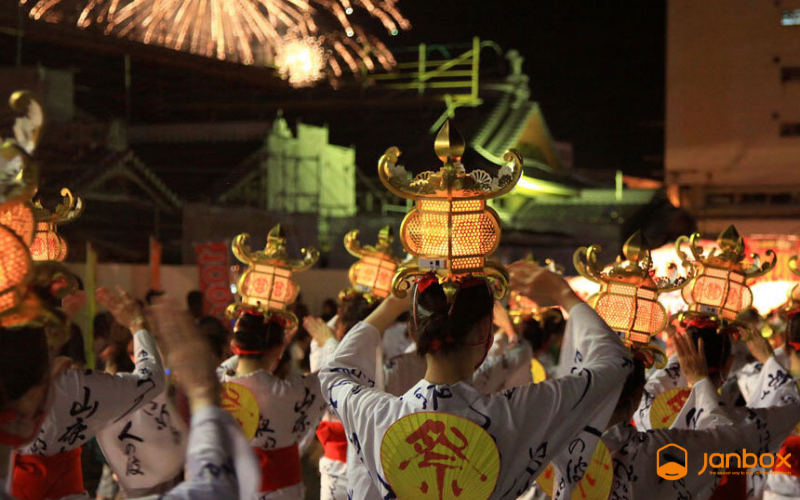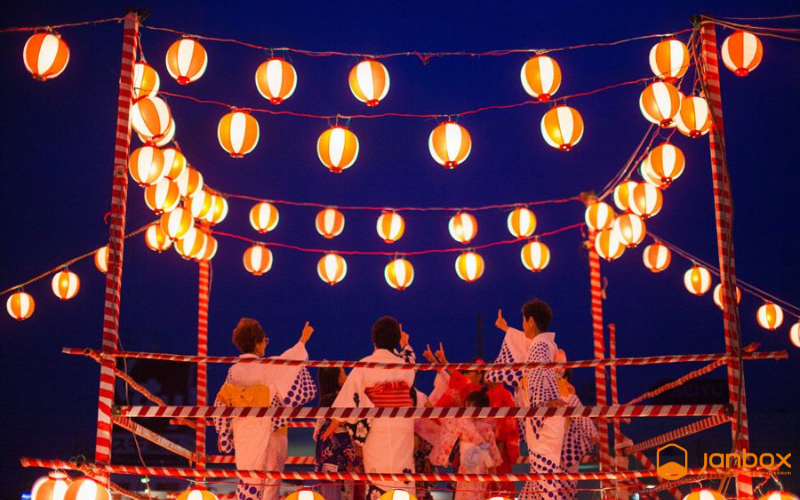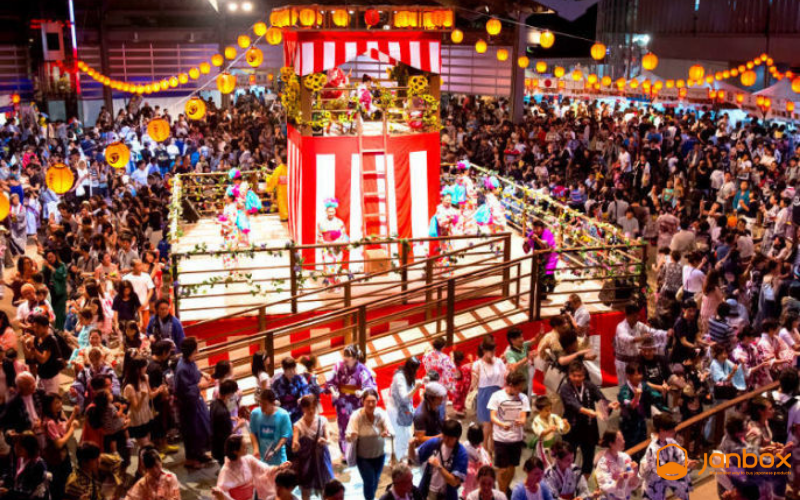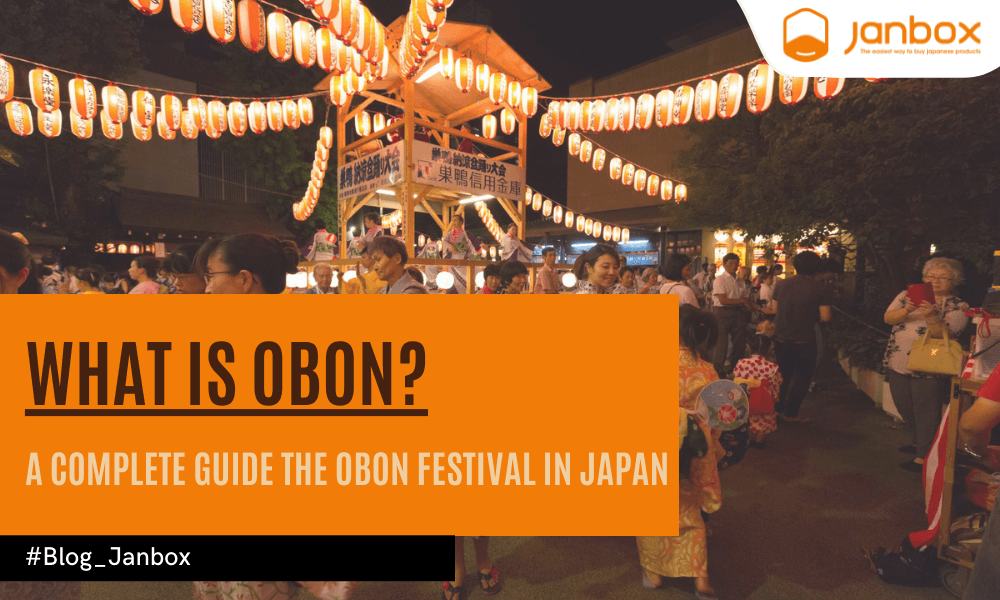While everyone in the world is familiar with Mexico’s famed celebration for the dead (El Da de Los Muertos), there is also a similar festival in Asia. It is the Obon celebration in Japan. Fans of the holidays, rejoice! There will be a long holiday for Westerners living and working in Japan, but for Japanese people, Obon is a time for a family reunion and is highly significant to their faith and religion. So, what is the Obon festival? Janbox walks you through this traditional Japanese holiday in this Obon festival comprehensive guide.
1. What is Obon? What is the purpose of the Japanese Obon festival?
Obon (お盆), also known as the Bon festival, is a Buddhist summer celebration held once a year to commemorate the Japanese people’s ancestors. Each year during Obon, it is believed that the souls of the ancestors return to our world to visit their families.
People visit their hometowns to pay homage to their forefathers and mothers during this period. They accomplish this by performing rituals such as cleaning the graves of dead relatives, making temple gifts, and displaying lights to aid in the spirits’ journey to the other side.

Obon – a Japanese special tradition – is a significant element of Japanese culture and is extensively celebrated throughout the country, but in varied ways depending on the location.
2. When is Obon celebrated?
On July 15, according to legend, Mokuren gave offerings to the monks so that the Obon celebration would take place on July 15th. However, each location has its own interpretation of the narrative. As a result, the Obon festival takes place at various periods around the country.

In Japan, there are three major time frames for the Bon festival:
- July Bon: According to the solar calendar, the July Bon festival, known as Shichigatsu Bon, takes place on July 15th. Tokyo and Yokohama in Kanagawa Prefecture are two cities that host the July Bon celebration.
- The traditional Obon celebration takes place on the 15th day of the seventh lunar month. Shimane Prefecture, Hiroshima Prefecture, Kagawa Prefecture, Kochi Prefecture are among the regions that celebrate Obon on the 15th day of the 7th lunar month.
- August Bon: The most well-known Bon event in Japan takes place on August 15th of the solar calendar. The Obon celebration in Kyoto is the largest Obon event in Japan.
3. When is Obon this year 2021?
The official dates of the Obon festival for 2021 are August 13-15, however, it will be observed in certain locations on July 13-15 of the lunar or solar calendar. Obon Week, which falls in the middle of August, is one of Japan’s three major holiday seasons, making it one of the busiest travel periods of the year.
Many Japanese will depart around August 10th and return on August 17th and 18th for Kyoto’s largest Obon celebration.
4. The origin of Japanese Obon
The Japanese Bon Festival is based on the Chinese Ghost Festival, which is a hybrid of the Buddhist Ylánpén and Taoist Zhongyuan festivals. Obon, also known as Bon (Day of the Dead), is a Buddhist-based ancient Japanese ritual. This event honors the memory of loved ones who have died.
This ritual has evolved into a family reunion celebration, a time when individuals return to their ancestral lands to visit and clean the graves of their forefathers and mothers. Japanese people also think that this is the period when the souls of the departed are permitted to visit their descendants.
Obon is an ancient Japanese holiday that dates back over 500 years. The narrative of a Buddhist disciple named Mokuren (Maha Maudgalyayana) is the inspiration for the event. He was a guy who had cultivated for many years and possessed a wide range of magical abilities, according to tradition.

He utilized magic power to track out his late mother since he missed her so much. When Mokuren witnessed his mother being sent into hell and suffering much as a result of her wicked karma and selfish actions while she was alive, he went to the Buddha for help.
Mokuren must make offerings to the monks on July 15th, according to the Buddha. On that same day, he followed the Buddha’s guidance and brought gifts to the world’s monks.
Mokuren’s mother was rescued from hell as a result of this, which made him quite pleased. Mokuren joyfully danced as he was reunited with his mother’s soul, which is also a traditional Obon festival dance that is being performed today.
Bon-Odori is the name of the dance. Mokuren’s filial piety is a well-known anecdote. Every year since then, the Japanese have celebrated the Obon holiday (Bon festival) to thank their parents and the souls of those who have passed away.
>> See more: Top 20 best things to buy in Japan
5. How do Japanese celebrate Obon?
The Bon festival lasts three to four days, although the commencement date varies throughout areas of Japan due to differing interpretations of customs and the belief that the spirits of loved ones return at different periods. region. The Obon event is divided into two parts: Mukaebon (Welcome to the Souls) and Okuribon (Departure of Souls).
The Obon ceremony is performed in the following order:
- The welcome and sending away of the soul:
Although Obon is celebrated on the 15th, families traditionally light a fire (light a torch) using the stem of the “Ogara” thorn tree or a pathway of lanterns to assist the spirits in returning home on the 13th. It is claimed that the deceased’s spirit will return to the people’s world by riding the smoke from this fire.
This smoke ensures that the spirit of the departed does not become disoriented and may safely return to their home, therefore it also serves as a “Michishirube” guide. The Japanese create holy horses by putting toothpicks or chopsticks into cucumbers to be able to greet their departed family.
- Visiting cemeteries in remembrance of the deceased:
The spirits will stay at home on the 14th and 15th and be served traditional foods by family members. Family members will also pay their respects to the grave at the same time. To respect their ancestors, they typically clean the graves, place flowers on them, burn incense, and provide water. After that, the family gathers and eats together. This is a significant moment to commemorate those who have died.
- A fire to guide the soul:
To send spirits back to the underworld, families will serve Okuri Dango sweets and build their cows out of eggplant and toothpicks on the 16th. Offerings such as Hasu Okashi (a lotus-shaped cake) and fruit will be prepared by the Japanese. The offerings vary every day, with Mukaedango (welcoming soul cake) on the 13th, Ohagi (a sort of rice flour cake) on the 14th, Soumen (flour bread) on the 15th, and Okuridango on the 16th (Bread to see the soul).
On the 16th, folks, like on the 13th, light a fire to see off the soul. To guide the soul back, people will light a lamp in the garden or place it in front of the gate. Large-scale fire-offering rites are even held in some areas. The fire-offering ritual in Kyoto is arguably the most famous example of a fire-offering ceremony to light the road for the spirits. Five fires were lit in turn in the five mountains around Kyoto for about an hour.

Large bonfires arranged in the shape of kanji. Starting with Daimonji, then Myo, Ho, and Funagata, the small Daimonji at the top of a smaller mountain called Hidari-Daimonji, close to the Golden Temple. Although there are different origins for the Fire Offering, most believe that the custom began in the Muromachi period (1336-1573).
Obon Festival dances will be conducted at Yusen-ji Temple at the foot of the mountains when the fire has died down. These dances are Daimoku and Sashi, and they generally begin at 9 p.m. and last approximately an hour. To this day, traditional dancing can be seen at festivals across the country, when large groups of people congregate in yukata summer kimonos and Geta wooden sandals to execute choreographed – albeit rather simple – dance routines.
The dances are usually held around a raised platform known as a ‘yagura,’ from which performers sing and play traditional instruments. The dancers around the yagura in a big circle, walking and clapping at the same time, the sound of wooden sandals clacking on the ground being probably one of the most memorable features of the event. In addition, numerous traditional activities are held, such as fishing or blindfolded watermelon crushing…
The event’s conclusion is the ceremony of launching a paper boat (Toro Nagashi) during the Obon holiday. Small paper boats with candles will be released into rivers to return souls. The candles within the boat have the same symbolism as a fire offering to return souls to their rightful realm. When the ceremony of releasing paper boats takes place in some places, spectacular fireworks are sent off to signify the conclusion of the Bon Matsuri celebration.
6. Where to experience Bon dance festivals?
Bon Dance Festivals will change from one location to the next due to differences in culture and customs. You can, however, participate in the three largest dance festivals in Japan: Gujo Odori (Gifu), Awa Odori (Tokushima), and Nishimonai Bon Odori (Akita). They share the same genesis but differ in how they are carried out. Tourists come to see this as the major attraction.
Conclusion
So, we hope you have gained a better knowledge of the question: what is Obon celebration by now. The Obon festival in Japan is one of the most important holidays in Japan, with a rich history and meaning of filial piety. If you are interested in learning more about this event, travel to Japan and participate. This will undoubtedly be an event that will help you learn more about Japanese culture. Alternatively, you may discover more about Obon by visiting Janbox’s website or by leaving a comment on this page.
We hope you found this article inspring! If you did, we’d love if you could share it with your fellow Japan lovers. You’re also welcome to join us on Facebook, Pinterest, Twitter and Instagram for more tips and inspiration!








